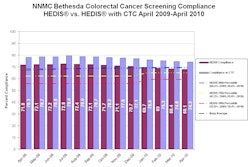Progress against colorectal cancer (CRC) mortality varies substantially by geographic region in the U.S., and different regional screening rates may be behind the differences, according to a new study in the July issue of Cancer Epidemiology, Biomarkers, and Prevention.
The authors found that colorectal cancer screening rates were lower and cancer rates were higher in Southern states compared to those in the Northeast. Indeed, the study in general showed a shift in colorectal cancer mortality from the Northeast to the South, wrote co-author Ahmedin Jemal, PhD, and colleagues from the American Cancer Society and Erasmus University in Rotterdam, the Netherlands (Cancer Epidemiol Biomarkers Prev, July 2011, Vol. 20:7, pp. 1296-1302).
"Generally, the uptake of CRC screening is lower and the proportion of late-stage CRC cases are higher in Southern states compared with other regions," the authors wrote.
With colorectal cancer placing third among the leading causes of cancer death, healthcare providers have counted on increased screening to reduce the toll. In fact, death rates for CTC have been decreasing the U.S. for several decades, dropping by 3% per year from 2003 to 2007 -- a period of increased CRC screening -- compared with 2% reductions in prior years.
Nevertheless, the mortality decrease varies widely across states, while the geographic patterns of CRC mortality rates are not documented in the peer-review literature, the authors wrote.
The researchers looked at time trends in age-standardized colorectal cancer death rates from 1990 through 2007 by state, as well as the change in geographic patterns of death rates for two periods -- 1990 to 1994 and 2003 to 2007. The group also examined state by state whether there was an association between the decrease in death rates and screening.
Data from the Surveillance, Epidemiology, and End Results (SEER) database for colon and rectal cancers from 1990 through 2007 were obtained for each of the 50 states and the District of Columbia. The authors described trends in the age-standardized death rates using joinpoint regression models and expressed the resulting trends as annual percentage changes.
State maps were created to examine changes in geographic patterns of CRC death rates. For each time interval, rates for each state were sorted in descending order and grouped into six categories. The highest and lowest categories represented the 10th and 90th percentiles, with the rest of the states divided into four equivalent groups.
For screening data on individuals 50 years and older, the authors looked to the Behavioral Risk Factor Surveillance System, an annual population-based survey performed by the U.S. Centers for Disease Control and Prevention (CDC). Screening was defined as reporting a fecal occult blood test within the past year, or sigmoidoscopy or colonoscopy in the past 10 years. Virtual colonoscopy utilization was not surveyed. Pearson correlation analyses were used to examine changes in CRC incidence and mortality.
The results showed that colorectal cancer mortality rates decreased for every state between 1990 and 2007 except for Mississippi. The drop in death rates from 1990 to 1994 and 2003 to 2007 ranged from only 9% in Alabama to more than 33% in Massachusetts, Rhode Island, New York, and Alaska; Mississippi and Wyoming showed no significant decrease.
"Generally, the Northeastern states showed the largest decreases, whereas the Southern states showed the smallest decreases," wrote Jemal and colleagues.
For example, between 1990 and 2007, the decline in colorectal cancer mortality rates in New York and Massachusetts accelerated from 2.5% per year in the 1990s to 4% to 5% per year in the 2000s, while CRC rates in Mississippi and Alabama showed little or no decrease during the entire time period, the group wrote.
Further analysis showed that trends for non-Hispanic whites and non-Hispanic blacks were generally similar. Colorectal cancer rates declined significantly for all 38 states among non-Hispanic whites and for non-Hispanic blacks in 20 of 27 states considered in the smaller analysis. For both minority groups, mortality trends were more favorable in Massachusetts and less favorable in Alabama, according to the authors. Among Hispanics, mortality decreased in six of the 13 states analyzed.
During the 1990 to 1994 period, the highest colorectal cancer mortality rates were found in the Northeast and North-Central parts of the country, and the lowest rates were in the West and South, the authors wrote. "In contrast, during 2003 to 2007, the highest CRC mortality rates were found in Southern states along the Appalachian corridor, including West Virginia, Kentucky, Mississippi, and Louisiana."
"Changes in CRC mortality rates from 1990-1994 to 2003-2007 by state were highly correlated (r = -0.65, p < 0.0001) with the percent of adults aged 50 and older who were current with CRC screening in 2004," they wrote.
Additional analysis showed that changes in incidence and mortality rates from 1992 to 1995 and 2003 to 2007 within each cancer registry were strongly correlated.
The geographic disparities were considerable, with states in the Northeast showing the largest declines and states in the South showing the smallest declines.
"CRC death rates shifted from the Northeastern states in the early 1990s to the Southern states along the Appalachian corridor in the mid 2000s," they wrote.
Ethnic variations
The authors cited the relatively higher proportion of blacks in Southern states as one factor that may have contributed to poorer outcomes in the region. Data show that blacks have poorer access to treatment and preventive services, have higher risk perception with regard to intervention, and are less likely to be screened or referred for colorectal cancer screening by their physicians.
Still, "the direction of the trend in CRC death rates within each state was generally similar in non-Hispanic blacks and non-Hispanic whites, though the magnitude of the trend varied for some states," they wrote. But the CRC mortality pattern for non-Hispanic whites was similar to those of all races.
"Accounting for state differences in the proportion of non-Hispanic black population slightly strengthened the association ... between percentage change in death rates and CRC screening rates for all races combined in the 38 states that met high-quality data for information on Hispanic ethnicity," Jemal and his team wrote.
The authors also noted that Hispanic subpopulations vary substantially by state distribution and colorectal cancer burden, while the analysis treated them as a single group. And while Hispanics' screening rates are lower, so are their smoking rates, and they tend to eat more vegetables and have legume-based diets that confer a measure of protection against CRC.
A main limitation of the study is that the authors could only speculate about the factors contributing to differences in progress against CRC using mortality data. Inaccuracies could have arisen in the accuracy of diagnostic data, the concordance between cancer diagnosis and death certificates, and the reporting of ethnicities, Jemal and colleagues wrote.
As for the shift in mortality prevalence toward the Southern and Appalachian states, the authors wrote that "improving screening rates through state-specific initiatives and/or expansion of the Colorectal Cancer Control Program of the Centers for Disease Control and Prevention to the Appalachian region and certain Southern states could lessen the disproportionately high burden of CRC in these states."




















